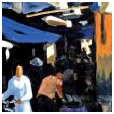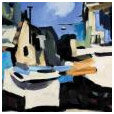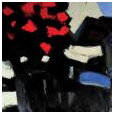Pham Luan
by Denise Heywood
Hang Dao Street. 2009. 100 x 120 cm
BOLD DAUBS of paint in muted shades with strong, flat patches of white characterise the urban scenes of Vietnamese artist Pham Luan. His use of powerful, primitive brush strokes with minimal details nevertheless evoke instantly the pulsatingly busy, narrow streets of his home, Hanoi, the capital of Vietnam.
Reminiscent of French Impressionism and its rendering of the light of the Mediterranean, Pham Luan’s vibrant paintings transpose this imagery into an Asian context, as if fusing disparate influences. Because they resemble art forms familiar to the West, it is tempting to make the comparison, and yet Pham Luan’s work reflects artistic realities that are part of his own Asian culture. As a result, his pictures of Hanoi’s streets and people have made him one of the most important contemporary artists in Vietnam.
Pham Luan was born in 1954 in Hanoi, where three generations of his family lived in the same street in the old quarter, and even as a child was deeply sensitive to the visual imagery of the people and the city around him. His desire to capture these sensations prompted him to teach himself painting while still in primary school, following patterns that have been part of Vietnamese visual culture for centuries. Vietnam is an ancient civilisation dating back to the 2nd century BC with a deep rooted and symbolic artistic tradition. As well as sculpture and sacred architecture inspired by Hinduism and contacts from maritime trade, silk painting, calligraphy, scroll painting, lacquer painting and ceramics flourished as part of its sinicised culture, born of its proximity to, and domination by, China throughout its history.
When the French colonised Vietnam and made it part of Indochina between 1887-1954, they brought their own artistic influences in the form of la mission civilisatrise, the civilising mission, and taught Vietnamese artists new perspectives. The first generation of graduates of the illustrious Ecole des Beaux Arts in Hanoi, established in 1925 and led by its inspirational first director Victor Tardieu, a student of Matisse, went on to become distinguished artists and the country’s first professional painters. Their works were a fusion of Western and Eastern artistic references, but resulting in styles that were uniquely Vietnamese. Pham Luan acknowledges these influences and, as his own style started to develop, his rendering of light and shadow unconsciously evolved as resembling the Impressionists. ‘Even in those early days, I loved to depict the play of lights,’ he recalls. Later on, after acquiring art books, he realised that the path of creativity he had chosen was similar to that of the Impressionists, and he grew to admire the masterpieces of Monet, Van Gogh and Cézanne.
Having started painting as a boy, initially copying portraits of Ho Chi Minh, he taught himself with books such as Buoc Dau Hoc Ve (First Steps in Drawing), by artist Nguyen Van Ty, learning how to conceive a picture and looking at works by celebrated Vietnamese artists such as To Ngoc Van, Bui Xuan Phai and Nguyen Sang.
Encouraged by his family, he used gouache on paper, which was cheaper and easier to find than other materials at the time. He started at art college but because of the Vietnam-American war it was relocated to a safer place outside Hanoi and the long journey prevented him from attending, so instead he went to the Hanoi Teachers’ Training College. His studies were then interrupted by military service, a period which actually helped shape his artistic path. ‘One of my first completed works is a sketch of houses on stilts in Thanh Hoa province where I was first stationed.’
Houses, streets and daily life in the old city are still his favourite subjects, rendered with deft, strong brushes of paint. A minimal palette, with just a few shades of beige and brown, a smear of blue, with bold outlines, disarm the spectator. In Sunny Lane, depicting little houses in Hanoi bathed in sunlight, the colours are solid, rich and creamy, as if the brilliance of the light has blinded the viewer to all detail. The brushstrokes have such a palpable, tactile look it seems as if the paint were still wet.
A woman appears at the lower left corner of the painting Small Alley, dressed in a white ao dai, the recently revived tunic and trouser suit favoured by women, pushing her bicycle and emerging into brilliant daylight from a dark alley where canopies cover the street to protect it from the tropical sun. The spatial and chromatic conception is bold. Her face has no detail at all, just a dab of dark and light skin. The scene of animation she is leaving is captured in a few pale colours, with flat brushstrokes, as if simplifying everything, uncluttered by detail. A small stool in a startling, brilliant red is the only primary colour in the piece, emerging at the bottom of the picture. ‘I am an artist who loves the play of lights and shadows,’ says Phan Luang. ‘I think that the contrast of light and shadows is crucial to the layout of the painting. I like using bright colours.’
In Street Vendors, portraying another crowded market, the blurred figures in conical hats show that, as in Impressionism, the human figure has lost its importance as the centre of the canvas, becoming instead something else, in a blend of composite forms where the artist has reconstructed reality. The walls of the narrow passageway’s houses enclose the viewer and it is only on looking up, towards the top left hand corner, that one glimpses a square of blue sky beyond to affirm that this is an exterior rather than an interior scene. As a veritable chronicler of old Hanoi, Pham Luan paints his city as all enveloping or ‘cosy’, as he describes it, bringing security, familiarity and identity. The urban dwelling and setting are almost womb-like, providing a framework not only for a picture but for life itself with its humanity and solidarity. ‘Even in the shadows there is still the warmth of light which suggests a cosy family life,’ he explains.
This subject matter of his home and its surroundings, the bustling neighbourhood where he has always lived, and where he built his studio 13 years ago, are his inspiration and the heart of his work. Hanoi is still a pedestrian’s city where space is absorbed at a walker’s - or a cyclist’s - pace. It is on a human scale where people’s activities, whether social or commercial, are central to individual and collective identity. ‘My paintings reflect contemporary scenes …. the multi-coloured little shops, the people and the traffic. I hope that my paintings capture the essence of contemporary life in Hanoi,’ he says. Hanoi’s old quarter still retains an atmosphere of a traditional Asian town where people live outside, as they did in the countryside, on the pavements, eating, washing, playing, socialising, trading and even sleeping, a city not yet transformed into the dazzling overpowering ultramodern megalopolis such as Shanghai, so that life still continues in a time honoured fashion and pace.
In Afternoon Market, the image is yet another typical urban scene, but a triangle of blue sky dominates the top and the abundant leaves of one of the many beautiful trees of Hanoi are visible. Once again, it is a setting on a human scale. ‘This familiarity is a continuous inspiration for me to paint Hanoi,’ says Pham Luan.
Perhaps it is this sense of security and solidarity with those around him that defines his work as Vietnamese. The turbulence of the country’s past - its war with America and centuries of conflict with China before that - is rarely glimpsed in his paintings. But because they are charged with a certain nostalgia, they reveal a search for peace and harmony, roots and identity, that reflect the sentimental and poetic nature of many Vietnamese artists who have been burdened by the legacy of their violent history, both recent and ancient. There is a need to redefine an artistic landscape.
The new freedom of expression signalled by the economic expansion of Doi Moi - the economic reforms in the 1980s - helped to shape a new generation of artists with an individualistic identity. While the rich artistic heritage of Vietnam was expressed in the great dynasties of the Chams and the Nguyen emperors of Hue, modern painting is also a reflection of ordinary life as it is lived by many Vietnamese.
‘For years, Vietnam was seen by many people around the world as a country of war,’ says Pham Luan. ‘I hope you will see in my paintings the other side of Vietnam: peace and grace … these traditional ways of life are crucial to Vietnam’s present and future identity’. Recognising that this is a society in transition, changing rapidly, he believes that family values are still important. ‘In order to retain the national character and identity these traditional values must be nurtured.’ The swift economic progress of Vietnam, together with its growing population and expanding cities, including Hanoi, are exciting but also overwhelming. Phan Luan believes that it is necessary to look back and reflect on these changes so that society can improve.
Married with two daughters, Pham Luan is dedicated to his family but focuses unceasingly on his work and its contribution to his country. A member of the Hanoi Fine Arts Association and the Vietnam Fine Arts Association, he is now exhibiting worldwide to great acclaim, from Hong Kong to the US, Europe and Britain, and is represented in the permanent collection of the National Fine Art Museum of Vietnam. His paintings, mirroring Western artistic influences yet reflecting his own Asian culture, conjure up a vision of a society that is maintaining old values while in the throes of embracing new ones. They capture not only a peaceful image of a once war-torn country, but embody the historic, artistic spirit of its people. ‘Through my work,’ he concludes, ‘I want to portray my love for my home, my country and the Vietnamese people’.
1: Hang Dao Street (2009), 100 x 120 cm
2: Small Alley (2009), 110 x 130 cm
3: Sunny lane (2009)
4: Twilight Moment (2009), 160 x 200 cm




